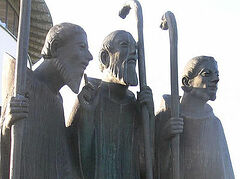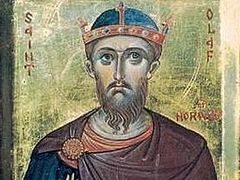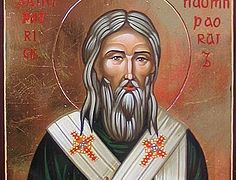We continue with an amazing series on the Orthodox saints of what is now call Benelux, by Matthew Hartley.
***
St. Amandus of Elnon (†675)
St. Remaclus of Stavelot (†c.673)
St. Hadelin of Celles (†c.690)
St. Trudo of Hesbaye (†c.698)
St. Livinus of Ghent (†657)
St. Willibrord of Utrecht (†739)
St. Adalbert of Egmond (†c.740)
St. Ludger of Utrecht (†809)
St. Odulfus of Evesham (†c.855)
Although, as noted previously, a Christian presence and Church structure had been present in the areas of the Low Countries from Roman times (indeed, perhaps as early as the first century), the widespread evangelization of these lands would be a phenomenon mainly of the seventh to eighth centuries. In this great undertaking, certain missionary saints shone with special brilliance, marking them among the great apostolic enlighteners of the Church’s history. They will constitute the focus of this section.
 St. Amandus St. Amandus (Amand), with whom we begin, was a great missionary, a holy hierarch, and a wonderworker. Born in the Poitou region of western France, of noble birth, he pursued monasticism against his family’s wishes, becoming a missionary bishop. Brought to the area of present-day Belgium at the behest of Frankish king Clotaire II, he evangelized the region of Flanders (an area basically corresponding to northern Belgium). Here his great holiness shone, for he endured much persecution and revilement for his labors. However, the miracles he worked, such as raising a hanged criminal from the dead, aided his efforts and brought great numbers into the fold of Christ. After many travels, where he worked further miracles, continued his missionary efforts, and established monasteries (including a couple in Ghent), he returned to the area and served from 647–650 as bishop of Maastricht. He provided crucial assistance to Sts. Itta and Gertrude (see below) in the establishment of their abbey in Nivelles. Resigning his see, he returned to his native France, where he reposed in great old age in a monastery later named for him; his soul was seen ascending to Heaven.
St. Amandus St. Amandus (Amand), with whom we begin, was a great missionary, a holy hierarch, and a wonderworker. Born in the Poitou region of western France, of noble birth, he pursued monasticism against his family’s wishes, becoming a missionary bishop. Brought to the area of present-day Belgium at the behest of Frankish king Clotaire II, he evangelized the region of Flanders (an area basically corresponding to northern Belgium). Here his great holiness shone, for he endured much persecution and revilement for his labors. However, the miracles he worked, such as raising a hanged criminal from the dead, aided his efforts and brought great numbers into the fold of Christ. After many travels, where he worked further miracles, continued his missionary efforts, and established monasteries (including a couple in Ghent), he returned to the area and served from 647–650 as bishop of Maastricht. He provided crucial assistance to Sts. Itta and Gertrude (see below) in the establishment of their abbey in Nivelles. Resigning his see, he returned to his native France, where he reposed in great old age in a monastery later named for him; his soul was seen ascending to Heaven.
 St. Remaclus St. Remaclus succeeded St. Amandus in the bishopric of Maastricht. He, too, was of French origin, hailing from Aquitaine. Like his predecessor, he was similarly missionary-minded. He established monasteries in Stavelot and Malmedy in the Wallonia region (roughly the southern part of modern Belgium). Assisting him was St. Hadelin, who had been a monk under St. Remaclus at Stavelot; St. Hadelin also founded monasteries, including one at Celles, where he later reposed after living out his days nearby as a hermit. St. Remaclus himself mentored numerous other saints while also evangelizing his diocese, principally through the spread of monasticism. One of his pupils, the hieromartyr St. Theodard (†c.670) succeeded him as bishop. St. Remaclus reposed at Stavelot, where his relics are kept.
St. Remaclus St. Remaclus succeeded St. Amandus in the bishopric of Maastricht. He, too, was of French origin, hailing from Aquitaine. Like his predecessor, he was similarly missionary-minded. He established monasteries in Stavelot and Malmedy in the Wallonia region (roughly the southern part of modern Belgium). Assisting him was St. Hadelin, who had been a monk under St. Remaclus at Stavelot; St. Hadelin also founded monasteries, including one at Celles, where he later reposed after living out his days nearby as a hermit. St. Remaclus himself mentored numerous other saints while also evangelizing his diocese, principally through the spread of monasticism. One of his pupils, the hieromartyr St. Theodard (†c.670) succeeded him as bishop. St. Remaclus reposed at Stavelot, where his relics are kept.
Among other distinguished and saintly disciples of St. Remaclus was St. Trudo, known for evangelizing the Hesbaye region. As such, he acted as a distant successor to the labors of St. Martin of Tongeren, discussed above. He tirelessly spread the Gospel and established churches and monasteries. The most famous of his establishments, in the Limburg province of present-day eastern Belgium, later bore his name. He also established a women’s convent.
 Gerard Seghers. The Martyrdom of Saint Livinus. National Museum in Warsaw
Gerard Seghers. The Martyrdom of Saint Livinus. National Museum in Warsaw
Mention should also be made of St. Livinus of Ghent, who evangelized the Flanders and Brabant regions. Of Irish origin, he studied for a time in England where he was mentored by St. Augustine of Canterbury (†604). He travelled to Zeeland in the western Netherlands, where pagans to whom he was preaching martyred him brutally. His relics were subsequently taken to Ghent.
The greatest of the evangelizers of the Low Countries, fittingly known as the Enlightener of the Netherlands and the Apostle to the Frisians, was St. Willibrord of Utrecht. St. Willibrord was of English birth, from Yorkshire near the coast of the North Sea. From before his birth his holy course of life had been symbolically foretold in a vision to his mother, in which she beheld the moon wax full and descend, so it seemed, into her mouth, whereupon it shone forth from her with splendid radiance. St. Willibrord’s father, Wilgils, a man of devout and holy life, left young Wilfrid in the care of the monastery of Ripon and retired to pursue a life of monastic struggle in an oratory he established on the River Wear.
 Icon of St. Willibrord of Utrecht
Icon of St. Willibrord of Utrecht
At Ripon Willibrord was brought up under the tutelage of St. Wilfrid of York (†c.710). Some years later Willibrord left for Ireland, going to the Abbey of Rath Melsigi where he was under the guidance of St. Egbert (†729), who later arranged for his mission to the Frisians.
At age thirty-three St. Willibrord set off in company with eleven companions to enlighten the lands of Frisia, which encompassed parts of the present-day Netherlands, Belgium, Luxembourg, and northern Germany. There he had the enthusiastic support of the Frankish leader Pepin, but the Frisians were still inveterately pagan and, moreover, on hostile terms with the neighboring Franks.
St. Willibrord threw himself into his work and began making strides in evangelizing the area. His base of operations was the city of Utrecht. He made a couple of trips to Rome to obtain papal blessing and support for his mission; on the second of these, at the Church of St. Cecilia, he was given the pallium and made archbishop, with his see in Utrecht.
The saint boldly confronted paganism head-on. He fervently denounced the error and futility of idol worship. He once publicly smashed an idol, for which someone struck him forcefully on the head with a sword—but the saint emerged miraculously unharmed and forgave his attacker. On another occasion, the saint directly refuted the alleged, and much feared, power of a local idol by baptizing three youths in a pool that had been dedicated to it.
St. Willibrord’s ministry was accompanied by abundant miracles. He once gave drink to a group of thirsty beggars without the water in his canteen diminishing at all. Similar miracles occurred in storehouses through his prayers, as supplies would be miraculously replenished. He once halted a plague at a convent and worked other wondrous feats through the grace that dwelt in him due to his great faith and personal holiness.
So successful was St. Willibrord that by the end of his archiepiscopal service paganism had been reduced to a small and dwindling presence in his area. Churches and monasteries had been built in numerous locations, including the famous Abbey of Echternach; thus were his accomplishments placed on a secure footing.
 Relics of St. Willibrord in Echternach, Luxembourg
Relics of St. Willibrord in Echternach, Luxembourg
St. Willibrord reposed in peace in the year 739. He was seen in brilliant, otherworldly light, and multiple people witnessed his soul rising in the company of angels. His relics, at Echternach in Luxembourg, have been glorified by many miracles, and every year to this day a “dancing procession” to them is held there.
 St. Adalbert of Egmond Among St. Willibrord’s numerous saintly assistants in the evangelical mission to Frisia was St. Adalbert the Archdeacon of Egmond. Of Northumbrian royal stock, like St. Willibrord he, too, received his spiritual formation at Rath Melsigi. He came to be particularly associated with Egmond in the northwestern Netherlands, in which place he reposed. A church built over his grave became the seed of Egmond Abbey, Holland’s first monastery. Sometime after his repose, St. Adalbert’s prayers are said to have once averted a pirate invasion by causing a thick protective fog to settle over the town.
St. Adalbert of Egmond Among St. Willibrord’s numerous saintly assistants in the evangelical mission to Frisia was St. Adalbert the Archdeacon of Egmond. Of Northumbrian royal stock, like St. Willibrord he, too, received his spiritual formation at Rath Melsigi. He came to be particularly associated with Egmond in the northwestern Netherlands, in which place he reposed. A church built over his grave became the seed of Egmond Abbey, Holland’s first monastery. Sometime after his repose, St. Adalbert’s prayers are said to have once averted a pirate invasion by causing a thick protective fog to settle over the town.
Another important evangelizer of this region of Europe who merits mention here was St. Ludger of Utrecht. Though he is principally known for his efforts among German populations, for which he gained the title of Apostle to the Saxons, he was born near Utrecht and was of Christian Frisian descent. He had seen the great St. Boniface, Enlightener of Germany, when the latter was in Frisia assisting St. Willibrord’s missionary efforts. He was educated in the cathedral school of Utrecht, which had been founded by St. Gregory (†776). He later labored in the area of Deventer in the Salland region of the eastern Netherlands, continuing the labors and recovering the relics of St. Lebuinus (†775), an Anglo-Saxon missionary to the Frisians. Taking charge of the missions to East Frisia, St. Ludger based his operations out of Dokkum, site of St. Boniface’s martyrdom in 754. Driven away for a time by hostile pagans, during which period he spent time in Rome and at Monte Cassino in Italy, before changed circumstances brought him back to the Netherlands, where he resumed vigorous missionary work in locales such as Heligoland, among others. One account tells of him curing a poet of blindness and converting him to Christ. He later left for missionary work in Germany, where he seems to have passed his remaining days before reposing in peace.
A final missionary figure to mention in this account is St. Odulfus. From Brabant, he was a monk active in missionary work in Frisia. He labored alongside St. Frederick of Utrecht. He reposed in Utrecht, and the miracles associated with his relics drew many pilgrims. His relics were later translated to Evesham in Worcestershire, England.
These great missionary saints vividly demonstrate the labors and sacrifices necessary to bring areas long steeped in pagan darkness to the light of Christ. May we draw inspiration from their examples, and have their prayers, as we try to live Christian lives in our own times—times that are seemingly intent on returning to that very darkness from which these saints once rescued their own people at such great cost and struggle.
To be continued…




